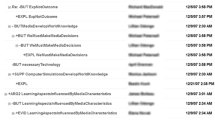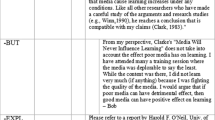Abstract
Online group debates hosted in asynchronous threaded discussions can facilitate critical thinking between discussants (and increase deeper understanding of complex problems) by eliminating the need for turn-taking while formulating and presenting premises to support and challenge claims. Yet to be determined is to what extent does the current number of posts (premises from teammates, premises from the opposing team, supportive replies to premises, and opposing replies to premises) induce production blocking to disrupt the generation of new premises. Statistical discourse analysis was conducted on 1554 postings from online debates produced by four cohorts of students enrolled in an online graduate-level course. The resulting stochastic model revealed that: (a) the number of premises posted by the other team, premises posted by teammates, and supportive replies from teammates were associated with the largest to smallest drop in the likelihood of posting a new premise, respectively; and (b) the number of oppositional replies from the other team was associated with an increased likelihood of posting a new premise. These findings provide evidence to support the use of specific strategies for structuring and sequencing the argumentation task to generate larger numbers of premises to achieve a deeper and more thorough analysis of problems and claims.

Similar content being viewed by others
References
Andriesen, J., & Coirier, P. (1999). Foundations of argumentative text processing. Amsterdam: Amsterdam University Press.
Bakeman, R., & Gottman, J. M. (1997). Observing interaction: An introduction to sequential analysis. Cambridge University Press.
Baruah, J., & Paulus, P. B. (2011). Category assignment and relatedness in the group ideation process. Journal of Experimental Social Psychology, 47, 1070–1077.
Benjamini, Y., Krieger, A. M., & Yekutieli, D. (2006). Adaptive linear step-up procedures that control the false discovery rate. Biometrika, 93, 491–507.
Bertsekas, D. P. (2014). Constrained optimization and Lagrange multiplier methods. New York: Academic.
Blackman, N. J. M., & Koval, J. J. (2000). Interval estimation for Cohen’s kappa as a measure of agreement. Statistics in Medicine, 19(5), 723–741.
Bouchard, T., Barsaloux, J., & Drauden, G. (1974). Brainstorming procedure, group size, and sex as determinants of the problem-solving effectiveness of groups and individuals. Journal of Applied Psychology, 59(2), 135.
Brooks, D., & Jeong, A. (2006). The effects of pre-structuring discussion threads on group interaction and group performance in computer-supported collaborative argumentation. Distance Education, 27(3), 371–390.
Camacho, L. M., & Paulus, P. B. (1995). The role of social anxiousness in group brainstorming. Journal of personality and social psychology, 68(6), 1071–1080.
Chin, C., & Brown, D. E. (2000). Learning in science: A comparison of deep and surface approaches. Journal of Research in Science Teaching, 37(2), 109–138.
Chiu, M. M., & Lehmann-Willenbrock, N. (2016). Statistical discourse analysis. Group Dynamics: Theory, Research, and Practice, 20(3), 242–258.
Connolly, T., Routhieaux, R. L., & Schneider, S. K. (1993). On the effectiveness of group brainstorming: Test of one underlying cognitive mechanism. Small Group Research, 24(4), 490–503.
Connolly, T., Jessup, L., & Valacich, J. (1990). Effects of anonymity and evaluative tone on idea generation in computer-mediated groups. Management Science, 36, 689–703.
Coskun, H., Paulus, P. B., Brown, V., & Sherwood, J. J. (2000). Cognitive stimulation and problem presentation in idea generation groups. Group Dynamics: Theory, Research, and Practice, 4, 307–329.
Dennis, A. R., & Valacich, J. S. (1993). Computer Brainstorms: More heads are better than one. Journal of Applied Psychology, 78, 531–537.
Derosa, D. M., Smith, C. L., & Hantula, D. A. (2007). The medium matters: Mining the long-promised merit of group interaction in creative idea generation tasks in a meta-analysis of the electronic group brainstorming literature. Computers in Human Behavior, 23(3), 1549–1581.
Deuja, A., Kohn, N., Paulus, P., & Korde, R. (2014). Taking a broad perspective before brainstorming. Group Dynamics: Theory, Research, and Practice, 18, 222–236.
Diehl, M., & Stroebe, W. (1987). Productivity loss in brainstorming groups: Toward the solution of a riddle. Journal of Personality and Social Psychology, 53, 497–509.
Diehl, M., & Stroebe, W. (1991). Productivity loss in idea-generating groups: Tracking down the blocking effect. Interpersonal Relations and Group Processes, 61(3), 392–403.
Dubrovsky, V. J., Kiesler, S., & Sethna, B. N. (1991). The equalization phenomenon: Status effects in computer-mediated and face-to-face decision-making groups. Human-computer Interaction, 6(2), 119–146.
Fern, E. (1982). The use of focus groups for idea generation: The effects of group size, acquaintanceship, and moderator on response quantity and quality. Journal of Marketing Research, 19(1), 1–13.
Fischer, F., Kollar, I., Stegmann, K., & Wecker, C. (2013). Toward a script theory of guidance in computer-supported collaborative learning. Educational Psychologist, 48(1), 56–66.
Fjermestad, J., & Hiltz, S. R. (1999). An assessment of group support systems experimental research: methodology and results. Journal of Management Information Systems, 15, 7–149.
Gallupe, R., Bastianutti, L., & Cooper, W. (1991). Unblocking brainstorms. Journal of Applied Psychology, 76(1), 137.
Gallupe, R., Dennis, A., Cooper, W., Valacich, J., Bastianutti, L., & Nunamaker, J. F. (1992). Electronic brainstorming and group size. Academy of Management Journal, 35, 350–369.
Goldstein, H. (2011). Multilevel statistical models. Sydney: Edward Arnold.
Gouran, D. S. (2000). The theoretical adequacy of the argument-centered perspective on decision-making and problem-solving in groups. In T. A. Hollihan (Ed.), Argument at century’s end: Reflecting on the past and envisioning the future (pp. 40–49). Annandale, VA: National Communication Association.
Hemberger, L., Kuhn, D., Matos, F., & Shi, Y. (2017). A dialogic path to evidence-based argumentative writing. The Journal of the Learning Sciences, 26(4), 575–607.
Hewitt, J. (2005). Toward an understanding of how threads die in asynchronous computer conferences. The Journal of the Learning Sciences, 14(4), 567–589.
Jeong, A. C. (2005). A guide to analyzing message-response sequences and group interaction patterns in computer-mediated communication. Distance Education, 26(3), 367–383. Retrieved October 1, 2020, from https://myweb.fsu.edu/ajeong/pubs/Jeong2005_AnalyzingInteraction.pdf.
Jonassen, D. H., & Kim, B. (2010). Arguing to learn and learning to argue: Design justifications and guidelines. Educational Technology Research and Development., 58(4), 439–457.
Kennedy, P. (2008). Guide to econometrics. New York: Wiley-Blackwell.
King, G., & Zeng, L. (2001). Logistic regression in rare events data. Political Analysis, 9, 137–163.
Kohn, N. W., & Smith, S. M. (2011). Collaborative fixation: Effects of others’ ideas on brainstorming. Applied Cognitive Psychology, 25(3), 359–371.
Konstantopoulos, S. (2008). The power of the test in three-level cluster randomized designs. Journal of Research on Educational Effectiveness, 1, 66–88.
Korde, R., & Paulus, P. B. (2017). Alternating individual and group idea generation: Finding the elusive synergy. Journal of Experimental Social Psychology, 70, 177–190.
Kuhn, D. (1993). Science as argument: Implications for teaching and learning scientific thinking. Science Education, 77(3), 319–337.
Lewis, A., Sadosky, T., & Connolly, T. (1975). The effectiveness of group brainstorming in engineering problem solving. IEEE Transactions on Engineering Management, 3, 119–124.
Ljung, G., & Box, G. (1979). On a measure of lack of fit in time series models. Biometrika, 66, 265–270.
MacKinnon, D. P., Lockwood, C. M., & Williams, J. (2004). Confidence limits for the indirect effect: Distribution of the product and resampling methods. Multivariate Behavioral Research, 39, 99–128.
Mercier, H., & Sperber, D. (2011). Why do humans reason? Arguments for an argumentative theory. Behavioral and Brain Sciences, 34(2), 57–74.
Meyers, R. A., Brashers, D. E., & Hanner, J. (2000). Majority-minority influence: Identifying argumentative patterns and predicting argument-outcome links. Journal of Communication, 50(4), 3–30.
Mullen, B., Johnson, C., & Salas, E. (1991). Productivity loss in brainstorming groups: A meta-analytic integration". Basic and Applied Social Psychology, 12(1), 3–23.
Nijstad, B. A., Stroebe, W., & Lodewijkx, H. F. M. (2003). Production blocking and idea generation: Does blocking interfere with cognitive processes? Journal of Experimental Social Psychology, 39, 531–554.
Nijstad, B. A., & Stroebe, W. (2006). How the group affects the mind: a cognitive model of idea generation in groups. Personality and Social Psychology Review, 10(3), 186–213.
Noroozi, O., Weinberger, A., Biemans, H., Mulder, M., & Chizari, M. (2012). Argumentation-based computer supported collaborative learning (ABCSCL): A synthesis of 15 years of research. Educational Research Review, 7(2), 79–106.
Noroozi, O., Weinberger, A., Biemans, H., Mulder, M., & Chizari, M. (2013). Facilitating argumentative knowledge construction through a transactive discussion script in CSCL. Computers and Education, 61, 59–76.
Nunamaker, J. F., Jr., Applegate, L., & Konsynski, B. (1987). Facilitating group creativity with GDSS. Journal of Management Information Systems, 3, 5–19.
Paulus, P., Dzindolet, M., Poletes, G., & Camacho, L. (1993). Perception of performance in group brainstorming: The illusion of group productivity. Personality and Social Psychology Bulletin, 19, 78–79.
Raudenbush, S. W., & Bryk, A. S. (2002). Hierarchical linear models: Applications and data analysis methods. (Vol. 1). London: Sage.
Rietzschel, E. F., Nijstad, B. A., & Stroebe, W. (2007). Relative accessibility of domain specific knowledge and creativity: The effects of knowledge activation on the quantity and originality of generated ideas. Journal of Experimental Social Psychology, 43, 933–946.
Sio, U., Kotovsky, K., & Cagan, J. (2017). The facilitating role of task alternation on group idea generation. Journal of Applied Research in Memory and Cognition, 6(4), 486–495.
Toulmin, S. E. (1958). The uses of argument. Cambridge: University Press.
Valacich, J., Dennis, A., & Connolly, T. (1994). Idea generation in computer-based groups. Organizational Behavior and Human Decision Processes, 57, 448–467.
Valacich, J., Jessup, L., Dennis, A., Nunamaker, J.F. Jr. (1992). A conceptual framework of anonymity in GSS. Proceedings of the 26th Hawaii International Conference on Systems Science, 4, 101–112.
Wang, H-C., Rosé, C., Cue, Y., Chang, C-Y. Huang, C-C., Li, T-Y. (2007). Thinking hard together: the long and short of collaborative idea generation in scientific inquiry. In Proceedings of Computer Supported Collaborative Learning, New Brunswick, NJ.
Author information
Authors and Affiliations
Corresponding author
Ethics declarations
Conflict of interest
The authors declare that they have no conflict of interest.
Additional information
Publisher's Note
Springer Nature remains neutral with regard to jurisdictional claims in published maps and institutional affiliations.
Rights and permissions
About this article
Cite this article
Jeong, A., Chiu, M.M. Production blocking in brainstorming arguments in online group debates and asynchronous threaded discussions. Education Tech Research Dev 68, 3097–3114 (2020). https://doi.org/10.1007/s11423-020-09845-7
Accepted:
Published:
Issue Date:
DOI: https://doi.org/10.1007/s11423-020-09845-7




